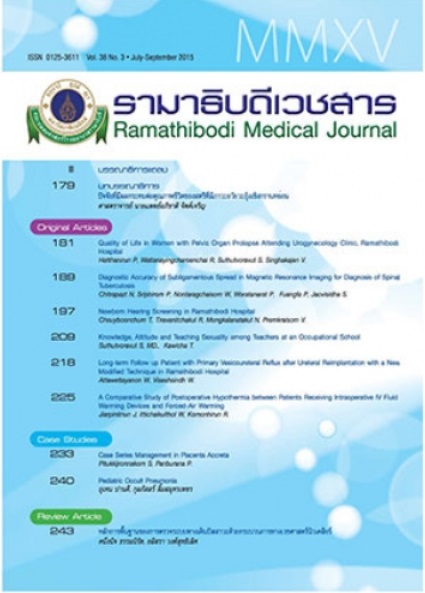Quality of Life in Women with Pelvic Organ Prolapse Attending Urogynecology Clinic, Ramathibodi Hospital
Keywords:
Pelvic organ prolapse, Quality of life, Associated factorsAbstract
Objective: To assess the impact of pelvic organ prolapse (POP) on quality of life (QOL) of women and factors associated with their effect.
Methods: The cross-section study was conducted by interviewing 140 women who came to the urogynecology clinic, Ramathibodi hospital. Demographic data, information about lower urinary tract symptoms and severity of POP were collected. Seven aspects of QOL including household work, entertainment activity, physical recreation, travel, participation social activity, emotion health and feeling frustration were assessed, using Thai version modified pelvic floor impact questionnaires-short form (PFIQ 7).
Results: The average age of subjects was 67.5 years. Seventy four percent were married , 80 % were housewives and almost all (99.3%) had at least one parity. Fifty percent had stage II of POP, and 80% had associated urinary symptoms. Regarding QOL, the most affected aspect was travel. All 7 aspects of QOL scores were significantly associated with severity of POP. Physical recreation, travel, emotional health and feeling frustration aspects of QOL scores were significantly associated with parity.
Conclusion: Majority of women with POP who came to urogynecology clinic were diagnosed at least stage II POP and mostly had associated urinary symptoms. Seven aspects of QOL of women were affected by POP especially travel domain.
References
Olsen AL, Smith VJ, Bergstrom JO, Colling JC, Clark AL. Epidemiology of surgically managed pelvic organ prolapse and urinary incontinence. Obstet Gynecol 1997;89:501-6.
Jelovsek JE, Maher C, Barber MD. Pelvic organ prolapse. Lancet 2007;369:1027-38.
Boyles SH, Weber AM, Meyn L. Procedures for pelvic organ prolapse in the United States, 1979-1997. Am J Obstet Gynecol 2003;188:108-15.
Piya-Anant M, Therasakvichya S, Leelaphatanadit C, Techatrisak K. Integrated health research program for the Thai elderly: prevalence of genital prolapse and effectiveness of pelvic floor exercise to prevent worsening of genital prolapse in elderly women. J Med Assoc Thai 2003;86:1509-12.
Chuenchompoonut V, Bunyavejchevin S, Wisawasukmongchol W, Taechakraichana N. Prevalence of genital prolapse in Thai menopausal women (using new standardization classification). J Med Assoc Thai 2005;88:1-4.
Bump RC, Mattiasson A, Bo K, Brubaker LP, DeLancey JO, Klarskov P, et al. The standardization of terminology of female pelvic organ prolapse and pelvic floor dysfunction. Am J Obstet Gynecol 1996;175:10-7.
Barber MD.Walters, MD.,Bump RC. Short forms of two condition-specific quality-of-life questionnaires for women with pelvic floor disorders (PFDI-20 and PFIQ-7). Am J Obstet Gynecol 2005;193,103-13.
Hair JF, Black WC, Babin BJ, Anderson RE, & Tatham RL. Multivariate data analysis 6 th ed. NJ: 2006. Pearson Prentice Hall.
Jelovsek JE, Barber MD. Women seeking treatment for advanced pelvic organ prolapse have decreased body image and quality of life. Am J Obstet Gynecol 2006;194:1455-61.
Samuelsson EC, Victor FT, Tibblin G, Svardsudd KF. Signs of genital prolapse in a Swedish population of women 20 to 59 years of age and possible related factors. Am J Obstet Gynecol 1999;180:299-305.
Fritel X, Varnoux N, Zins M, Breart G, Ringa V. Symptomatic pelvic organprolapse at midlife, quality of life, and risk factors. Obstet Gynecol 2009,113:609-16.
Ellerkmann RM, Cundiff GW, Melick CF, Nihira MA, Leffl er K, Bent AE. Correlation of symptoms with location and severity of pelvic organ prolapse. Am J Obstet Gynecol 2011;185:1332-7.
Dhital R, Otsuka K, Poudel KC, Yasuoka J, Dangal G, Jimba M. Improved quality of life after surgery for pelvic organ prolapse in Nepalese women. BMC Womens Health 2013;13:22.
Chan SS, Cheung RY, Yiu KW, Lee LL, Pang AW, Chung TK. Symptoms, quality of life, and factors affecting women's treatment decisions regarding pelvic organ prolapse. Int Urogynecol 2012;23:1027-33.
Digesu GA, Chaliha C, Salvatore S, Hutchings A, Khullar V. Relationship of severity of vaginal prolapse symptoms and quality of life. Br J Obstet Gynaecol 2005;112:971-6.
Downloads
How to Cite
Issue
Section
License
Copyright (c) 2015 By the authors. Licensee RMJ, Faculty of Medicine Ramathibodi Hospital, Mahidol University, Bangkok, Thailand

This work is licensed under a Creative Commons Attribution-NonCommercial-NoDerivatives 4.0 International License.












